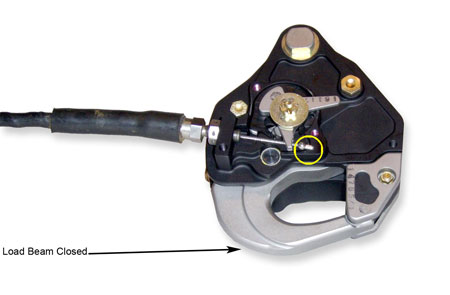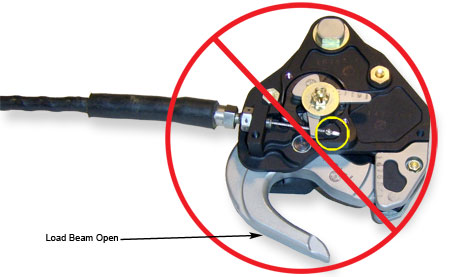Important Troubleshooting Tip for the TALON Keeperless Cargo Hook
Saturday, August 15, 2009

Did you know that incorrect rigging adjustment of the mechanical release cable can lead to an inadvertent load release? This can be caused during external load operations where the motion of the cargo hook and suspension system can move the cable sufficiently to activate the hook release mechanism.

 Figure 2 — Picture of improper load beam position. The cargo hook load beam is open. If the mechanical cable free play is set now, there may not be enough free play in the cable (circled in yellow) when the hook is closed.
Figure 2 — Picture of improper load beam position. The cargo hook load beam is open. If the mechanical cable free play is set now, there may not be enough free play in the cable (circled in yellow) when the hook is closed.Because of this, it is critical that the manual release cable rigging be set at the hook each time the hook is installed on the aircraft. As each cargo hook installation has unique requirements for the rigging setup, the appropriate user manual should be referenced for proper instructions in rigging the manual release cable.
Onboard Systems has recently received reports from the field about operators who have rigged the mechanical release cable on the TALON Keeperless style cargo hooks with the load beam in the open position—which could lead to an inadvertent load release.
It is critical that the load beam of the Onboard Systems TALON Keeperless style cargo hook is closed and fully locked before installation of the mechanical release cable and setting the cable free play. If the free play is set while the load beam is in the open position, when the load beam is closed it may reduce the amount of free play to an unsafe level that will not allow adequate margin of safety during external load operations. The reduced level of free play on the cable may result in inadvertently activating the release mechanism on the hook during operations, which could cause an inadvertent load release.
Our product documentation recommends that after the free play is set, you should move the hook and associated suspension system throughout its full range of motion while observing free play. You should also check that the manual release cable housing is not kinked or pulled tight in any hook or swing frame position.
Because Onboard Systems is dedicated to supporting helicopter external load operators, we recently issued an Alert Service Letter about this. You can view this document by clicking here.
Document Update Service
To ensure that you are always informed about changes in your product documentation and that you receive any pertinent service bulletins, Onboard Systems has implemented an automated Document Update Service through our website. Simply enter your contact preferences, check off the list of products that you own, and our system will either fax or email you if the documentation for your products is updated, or if there are any service bulletins issued for one of your Onboard products.
We strongly encourage all of our customers to take advantage of this free service.
Tags
vol6-iss4keeperless cargo hookstroubleshooting guideMore Articles
Return for Service Shipping Tips
International "Return for Service" shipments can be tricky. Here are some tips.
Get The Hook
Stay informed! Sign up for our quarterly newsletter, The Hook.
Convenient Email Invoices
How to get an invoice before your order arrives to help with customs paperwork and internal receiving processes.
Service Life Update for Barry Longlines
Barry has modified the service life calculation for their synthetic helicopter longlines.
How to Upgrade Your Equipment
We strive to make it simple and cost-effective for our customers to upgrade their equipment.
Wanted: Reviews & Testimonials
We would love to hear about how our products or services have helped you.


